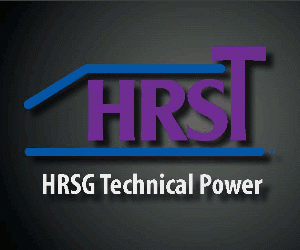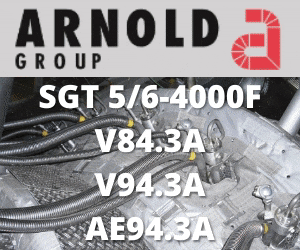You could forgive attendees at the Combined Cycle Users Group (CCUG) 2021 virtual conference if their eyes glazed over looking at slides on how to modify equipment and/or operating sequences to meet changing performance objectives. Several of the presentations could have been half- to full-day seminars by themselves. At the same time, it shows the quality and depth of the content the conference displays year over year.
Collectively, as suggested by the summaries below, they attest to how combined-cycle facilities are having to adapt to meet today’s reality and how much more adapting will be required in the future, if present trends hold. Let’s begin with the more straightforward ideas and work our way up the food chain of complexity.
Generator fast purge. There’s a premium on minutes or hours that can be knocked off of a start or shutdown sequence, especially at plants experiencing more downtime between runs. One 4 × 2 facility, commissioned in 2002 with Siemens Energy 501FD2s, Nooter/Eriksen HRSGs, and Siemens KN steam turbine/generators, grabbed a few of those precious hours by installing a new automated fast-purge system for its hydrogen-cooled generators. Report was presented by Rob Kallgren, Lectrodryer, and the plant’s engineer.
Bottom line is that the plant cut generator purge time from 12 to four hours, and added the ability to “emergency purge,” something the presenters said most combined-cycle plants do not have. Also, the automated system can purge during a storm, thereby assuring staff can remain inside when there’s lightning in the vicinity.
The Lectrodryer package includes a generator fast-degas system (GFD) and a generator gas monitoring and control piping skid. During a spring outage earlier this year, the plant installed the system (Fig 1) in three weeks. Although the plant has not yet done this, the system can be equipped so purging is done entirely from the control room.
Condenser losses. Performance engineers have been chasing thermal losses in condensers for decades. Collin Eckel, Intek inc, discussed how four categories of new instrumentation can make it easier to both monitor condenser performance and identify the root causes of degradation.
Standard instrumentation for cooling-water inlet and outlet temperatures, steam pressure and temperature, and condensate temperature allows you to calculate condenser performance based on the cleanliness factor but that’s about it, and that can be misleading, Eckel stressed.
Adding instrumentation for air in-leakage; cooling-water flow, temperature and fouling, and high-density temperature arrays; and differential-pressure meters (Fig 2), allows a far richer and deeper analysis for troubleshooting losses and what to do about them. Good computational flow dynamics (CFD) modeling is necessary to determine the best locations for these instruments.
As examples, the RheoVac air in-leakage monitors give an absolute measure of all non-condensable gases, a mass ratio (measure of vacuum quality), flow in acfm at the common header before the vacuum pump, and mass flow ahead of the steam-jet ejector. The high-density temperature array—in one case 192 individual measurements—provides data on air binding and micro-fouling.
The slides include graphs and graphics showing how the data are converted into performance insights, supported by several case studies.
Variable load paths. Evan Almberg, HRST Inc, opened his slides with what could be called “the writing on the wall.” According to the Energy Information Administration (EIA), 70% of all 2021 planned new capacity additions in the US are solar and wind. Thus, gas turbines and combined cycles will find even more ways to be flexible into the future.
Variable load path (VLP) operation is one such way. The typical GT operating curve is linear, Almberg said, fixing the turbine exhaust gas (TEG) flow rate and temperature based on cold, average, or hot ambient temperature. Essence of VLP is to modify the system to operate within an “envelope” in which GT load and TEG are controlled independently by modulating the IGVs to achieve the desired TEG mass flow (Fig 3).
The balance of Almberg’s slides explains five categories of impacts on the HRSG of operating within this envelope: tube metal temperatures and overheat, attemperator overspray and valve capacities, rated steaming capacity and maximum allowable working pressure, economizer downflow and instability, and steam separation and carryover.
All of these can be addressed with equipment modifications or changes to lifecycle expectations, but the important point is to intimately understand the impacts using detailed thermal analysis, and then optimize the upgrade options with a practical operating envelope (Fig 4).
Simple-cycle startup speed in a combined cycle. HRST’s Brandon Hall and Anand Gupta, along with Joseph Miller, The Energy Corp (TEC), delivered a treatise on whether and how a plant can adapt to meet the 30-min non-spinning reserve (NSR) markets (the 10-min market is the domain of aero machines, they said). Five combined cycle fast-start considerations addressed were drum ramp rates, purge-time calculation/credit, startup procedure checks, venting capacity, and demineralized-water capacity. The slides dive deep into the analysis for each category.
The bottom line is that many older combined cycles can adapt to participate in the NSR30 markets (Table 1) but there are, of course, risks and rewards (Table 2). Some of the risks are not insignificant when modifying a unit for faster starts—such as premature-ignition and water-induction events—but still could be offset by the financial rewards.
Performance gains for high-capacity-factor plants. Sam Korellis, EPRI, began with some statistics on the Top 20 combined-cycle plants to engage the audience in a review of techniques to improve heat rate and boost output:
-
- The Top-20 plants have an average 88% capacity factor, while the rest of the fleet hovers at around 60%.
- Heat rate for the Top 20 averages 6860 Btu/kWh, the best combined-cycle heat rate is 6649 Btu/kWh, and the remainder of the fleet averages 7400.
- A 1% improvement in heat rate can save a 1000-MW facility $1.3-million in fuel costs annually.
Korellis’ slides amount to a summary of EPRI products, including report #3002005048 which identifies and analyzes 50 modifications and actions to improve combined-cycle heat rate, 32 capital projects, and 18 maintenance actions; “first of a kind” guidelines for combined-cycle performance monitoring and recovery; and a gas-turbine performance analyzer.
A few salient points:
-
- Through EPRI onsite projects, one plant found six steam/water leaks which accounted for a 0.8% heat-rate impact, one leak alone amounting to 0.6%; another plant discovered nine leaks for a total penalty of 0.6%.
- Installing and using a performance monitoring system is a high-cost, high-return capital project.
- Installing HEPA filters ahead of the gas turbine is a medium-cost, high-return mod.
- Reducing condenser air in-leakage and repairing valves in high-energy piping systems are low-cost, high-return maintenance actions
- Monitoring control loops (several companies supply this software) via data from the plant historian is a low-cost means of identifying easily correctable tuning problems, valve issues, and process inefficiencies.





